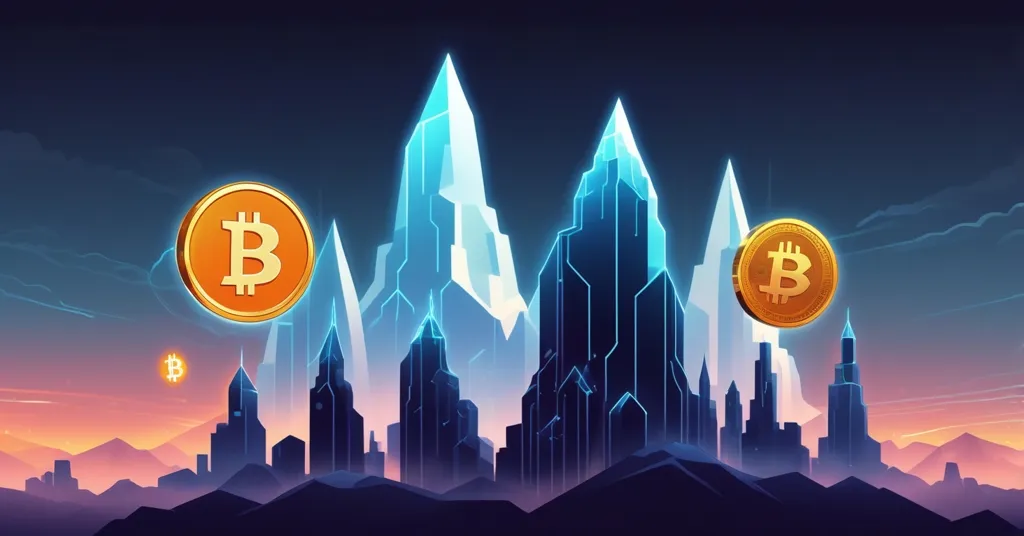BlockDAG, Hedera, Avalanche, Ondo: 2025 Crypto Stars or Hype Traps?

BlockDAG, Hedera, Avalanche, & Ondo: 2025 Crypto Contenders or Just More Hype?
With the crypto market buzzing about a potentially explosive 2025, driven by Bitcoin’s upcoming halving, four projects are being touted as top picks for investors: BlockDAG, Hedera, Avalanche, and Ondo Finance. Are these truly standout cryptocurrencies for the year ahead, or just another wave of speculative noise in a space notorious for broken promises?
- BlockDAG’s Bold Claims: A $289M presale and a speculative 10,000x return from $0.0018 per coin.
- Hedera’s Corporate Play: Backed by Google and IBM, targeting business solutions with Hashgraph tech.
- Avalanche’s Speed: A scalable Ethereum rival excelling in DeFi, gaming, and NFTs.
- Ondo’s TradFi Vision: Tokenizing securities like U.S. Treasuries to bridge traditional finance and blockchain.
Why 2025 Could Be a Turning Point
Before diving into these projects, let’s set the stage. Bitcoin’s halving, expected in 2024, historically sparks bull runs by slashing mining rewards and tightening supply, often lifting the entire market. If patterns from 2012, 2016, and 2020 hold, 2025 could see heightened speculation as capital flows from BTC to altcoins, influenced by events like the Bitcoin halving impact on crypto prices. But macro headwinds like rising interest rates, inflation concerns, or regulatory crackdowns could dampen the party. Plus, with thousands of projects vying for attention, separating signal from noise is tougher than ever. Against this backdrop, let’s dissect whether BlockDAG, Hedera, Avalanche, and Ondo have the chops to deliver—or if they’re just riding the hype train.
BlockDAG: Moonshot or Mirage?
Could a $0.0018 coin really soar to $18 overnight, or is BlockDAG (BDAG) just another crypto fairy tale? With a staggering $289 million raised in its presale, over 22.1 billion coins sold, and 1.5 million users reportedly on its X1 mining app, the numbers sound impressive. Add a live testnet, a CertiK security audit, and a rare public team, and BlockDAG appears more legit than most presale scams, as detailed in resources like the BlockDAG project overview. Early investors from batch 1 have already seen a 2,520% return, with the price frozen at $0.0018 until June 13. The big pitch? A speculative jump to $18, promising a 10,000x windfall.
Now, let’s slam on the brakes. A 10,000x return isn’t a moonshot; it’s a ticket to a galaxy far, far away—and most investors never make it past the launchpad. Bitcoin’s early gains were a historical anomaly, and even meme coins like Shiba Inu, which saw insane spikes, rode pure speculation, not utility. BlockDAG’s marketing reeks of FOMO-baiting, targeting retail dreamers desperate for the “next big thing,” despite some credibility from efforts like the CertiK audit boosting investor trust. The presale structure—spanning multiple batches with escalating prices—suggests a focus on early hype over long-term value. And while the X1 mining app sounds cool, is it a genuine onboarding tool or just a gimmick? Without hard adoption metrics or a killer use case, this could easily join the graveyard of overhyped altcoins from the 2017 ICO craze or 2021 meme pumps. The audit and transparency help, but history screams caution. If you’re tempted, tread lightly—very lightly.
Hedera: Enterprise Focus and Big Backers
While BlockDAG banks on retail buzz, Hedera (HBAR) takes a starkly different path, wooing corporate giants with a polished, business-first approach. Supported by heavyweights like Google and IBM, Hedera uses Hashgraph technology—a Directed Acyclic Graph (DAG) structure, further explained in insights from Hedera’s Hashgraph technology overview. Imagine DAG as a web of transactions flowing in one direction, unlike the slow, linear chain of traditional blockchains, enabling faster processing and lower energy use. Its focus is real-world utility: think supply chain tracking, identity verification, and green initiatives. One example is its potential use in tracking carbon credits for sustainability projects, a growing corporate need.
Decentralization Trade-Offs
Hedera’s recent moves add weight. As of September 2024, it open-sourced its codebase under the Linux Foundation’s Decentralized Trust initiative, a nod to broader Web3 collaboration. Events like HederaCon in February 2025, alongside ETHDenver, further cement its relevance. But here’s the rub for crypto purists: its governance, led by a council of up to 39 corporations, sacrifices the decentralization we cherish in Bitcoin. Corporate voting controls key decisions, raising risks of overreach or censorship—hardly the permissionless rebellion BTC stands for, a concern echoed in community discussions on Hedera’s enterprise adoption challenges. Counterpoint: this structure might shield Hedera from the wild volatility of fully open networks, appealing to risk-averse enterprises. Bitcoin’s untouchable ethos remains the gold standard, but Hedera’s compromises could open doors BTC can’t. If you’re betting on mainstream blockchain adoption over ideological purity, this might be your play.
Avalanche: Ethereum’s Faster Rival
Can Avalanche (AVAX) dethrone Ethereum with speed and scalability? This layer-1 blockchain offers near-instant transactions and dirt-cheap fees, a stark contrast to Ethereum’s congestion and gas costs. Its secret sauce is custom subnets—think mini-blockchains under the Avalanche umbrella, each tailored for a specific app or purpose, like a custom highway lane for faster traffic. This flexibility has made AVAX a hotspot for decentralized finance (DeFi), gaming, and non-fungible tokens (NFTs), with comparisons often drawn in discussions like those on Avalanche’s scalability versus Ethereum. Projects like Crabada, a play-to-earn game, showcase its niche in gaming, processing transactions at a fraction of Ethereum’s cost.
Competitive Hurdles
Yet, Avalanche isn’t skating on easy ice. Ethereum, despite its flaws, holds a massive first-mover advantage with a sprawling developer ecosystem and upgrades like sharding on the horizon to tackle scalability. AVAX also faces heat from other layer-1s like Solana and Cardano, all scrapping for the same DeFi and NFT market share. While Avalanche’s tech—boasting transaction speeds under 2 seconds—gives it an edge, long-term staying power depends on outpacing Ethereum’s network effects and fending off rivals. A counterpoint: Ethereum’s brand loyalty might outweigh pure tech advantages, as developers often stick with the devil they know. Bitcoin doesn’t need to be fast for DeFi; it’s the hardest money ever created, and that’s its superpower. Avalanche fills a different niche, but don’t expect a coronation just yet.
Ondo Finance: Bridging Wall Street and Blockchain
Could Ondo Finance (ONDO) drag traditional finance into the crypto age? Its mission is ambitious: tokenizing real-world assets like U.S. Treasuries into digital tokens on a blockchain, so they can be traded or used in DeFi apps like lending protocols. Picture owning a slice of government bonds as a crypto token, earning yield in a decentralized pool—that’s the vision, with deeper insights available through Ondo’s take on tokenizing traditional assets. Targeting financial institutions, Ondo emphasizes regulatory compliance, aiming to blend the old guard of Wall Street with blockchain’s disruptive potential.
Regulatory Roadblocks
The path forward is anything but smooth. Regulatory uncertainty looms large—agencies like the SEC have been cracking down on tokenized assets, as seen in cases like Ripple, viewing them as unregistered securities. Global frameworks are patchy at best, and institutional adoption crawls at a snail’s pace. While Ondo’s concept is innovative, specifics on partnerships or live products remain scarce in public data, leaving questions about near-term impact, though updates can be tracked via Ondo Finance’s latest news. A counterpoint: if regulators ever align, TradFi integration could legitimize crypto in ways Bitcoin’s raw rebellion can’t, bringing billions in capital. For those rooting for disruption, Ondo’s potential to erode centralized financial gatekeepers is tantalizing, but patience is mandatory. If Wall Street gets on board, could Ondo redefine the game? Time will tell.
Key Takeaways and Burning Questions
- Is BlockDAG a top crypto investment for 2025 or pure speculation?
BlockDAG’s $289M presale and public team suggest some credibility, but the 10,000x return prediction to $18 lacks any real fundamentals. History shows such moonshots rarely deliver, often exploiting retail FOMO. Approach with extreme caution—this could be another flash in the pan. - How does Hedera’s corporate model impact its role in blockchain technology?
Backed by Google and IBM, Hedera’s council-led governance prioritizes enterprise adoption over Bitcoin’s decentralized ethos. This suits use cases like supply chain tracking but sacrifices censorship resistance. It’s a trade-off that could drive mainstream uptake, if you’re willing to overlook the centralization. - Can Avalanche compete with Ethereum in DeFi and gaming by 2025?
Avalanche’s fast transactions and custom subnets outpace Ethereum’s current congestion, shining in DeFi and NFT niches. Yet, Ethereum’s massive ecosystem and upgrades may keep it dominant. AVAX has a shot in specific sectors, but dethroning the king is a tall order. - What challenges does Ondo Finance face in merging TradFi with DeFi?
Tokenizing assets like U.S. Treasuries is groundbreaking, but regulatory scrutiny from bodies like the SEC poses steep hurdles. Institutional uptake is slow, making this a long-term bet. Ondo’s vision holds promise, though immediate disruption seems unlikely. - How might the 2025 Bitcoin halving influence these altcoin projects?
Bitcoin’s halving could ignite a bull run, lifting altcoins like BlockDAG, Hedera, Avalanche, and Ondo with speculative capital. However, macro factors—interest rates, regulatory shifts—might temper the frenzy. Not every project will survive the cycle, regardless of market fever.
Navigating the crypto market in 2025 will be a brutal tightrope walk between raw opportunity and outright nonsense. BlockDAG’s presale haul and lofty promises might lure risk-takers, but they scream red flags to anyone who’s survived past crashes. Hedera and Avalanche bring more tangible utility, serving enterprise and DeFi needs, yet grapple with centralization concerns and fierce competition. Ondo Finance plays in a fascinating but frustratingly slow arena of institutional integration, where regulatory barriers could stall progress, though it remains one of the projects highlighted among the best cryptos to watch in the current market.
As Bitcoin maximalists, we can’t help but stack these altcoins against BTC’s unyielding commitment to decentralization and freedom. They each carve out niches Bitcoin doesn’t target—corporate solutions, scalable apps, tokenized securities—but none match the ideological heft of the original crypto. Still, in the spirit of effective accelerationism, we salute tech that chips away at the status quo, provided it doesn’t fleece the masses. A quick reminder: none of this is financial advice. Crypto is a high-risk game—only wager what you can afford to lose, and dig deeper than the shiny marketing. As we push toward a decentralized future, which of these projects do you think truly challenges the system—and which are just static in the signal?



